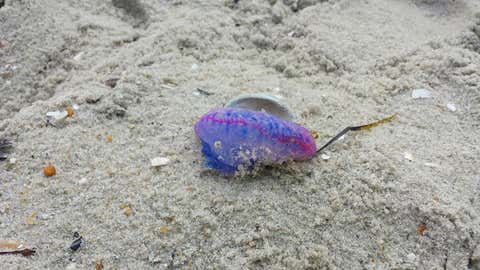At least 30 venomous Portguese man o' war have been spotted on New Jersey beaches — one week after beachgoers got a rare sighting of the first jellyfish-like creature to wash up on Harvey Cedars Beach near Ocean County, N.J.
The organism has long, thin tentacles that are filled with venom used to paralyze and kill its prey. According to National Geographic, it moves by floating on the water’s surface, drifting on the currents, catching the wind.

“When the wind is coming from the northeast, warm water from the Gulf Stream comes to shore,” the Harvey Cedars Beach Patrol wrote on its Facebook page. The team posted an image of the Portuguese man o’ war, also known as “floating terror,” as a warning for beach visitors. “Always be aware of your surroundings in the ocean and always swim near a lifeguard.”
Paul Bologna, a jellyfish expert and director of Marine Biology and Coastal Sciences Program at Montclair State University, said that the man o’ war is “very dangerous” and has a “very painful sting,” according to the Asbury Park Press. Even if a man o’ war is washed up on the beach, Bologna says that people should leave it alone for their stinging cells are still active.
Though stings are rarely deadly, they are extremely painful and often lead to scarring. Stung victims are recommended to seek immediate medical attention.
Portuguese man o’ wars are often confused for jellyfish, but unlike true jellies, these gelatinous animals are composed of many creatures called zooids. Zooids cannot survive alone, and according to Southeastern Regional Taxonomic Center, four unique zooids together make up the Portuguese man o’ war: The gas-filled float that sits on the ocean’s surface, the feeding tentacles, the prey-capturing tentacles, and the reproductive polyps.
MORE ON WEATHER.COM: Amazing Close Up Photos of Portuguese Man o War




